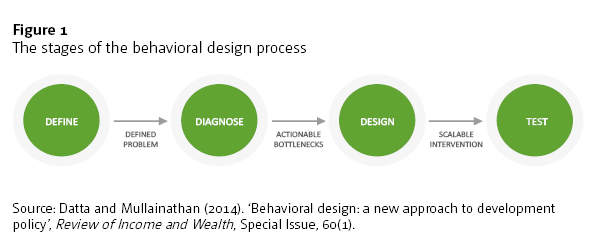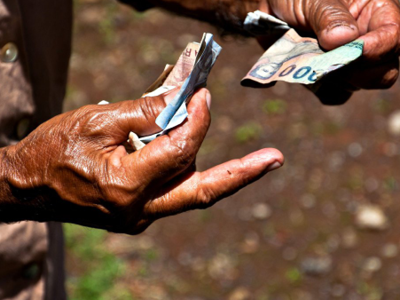Policy Brief
Lessons from Behavioural Economics for Policy-Making
Policy design principles based on insights from psychology and economics could have a major impact on the effectiveness of policy implementation in areas such as under-saving, contract design, the measurement of vulnerability, and political support for redistributive policies both in the global South and North.
Taking behavioural policy design principles into account can help in developing more effective policy
Transaction costs, lack of trust, information gaps, social barriers, and a range of behavioural biases are the five key constraints on savings in developing countries
Membership of a highly-connected network leads to higher savings and better use of such savings
An individual’s wellbeing depends not only on their current income but also on the difference between their current income and an expected level
How rational are we?
Imperfections of human decision-making
In the last two decades, questioning of the economics textbook model of individual choice behaviour has accelerated. It has become clear that the cost of assuming 100 per cent rationality has exceeded the benefits in many applications of economic theory. It is widely accepted that budget constraints need to be taken into account when planning activities. Equally, the fact that mental resources are scarce should be taken into account in policymaking—attention, understanding, and cognitive capacity are not infinite, nor is self-control unlimited. In light of this background, UNU-WIDER launched a research project* on poverty and behavioural economics to take stock of current knowledge, draw out major policy implications, and to chart promising areas for research within behavioural development economics.
Behavioural principles for policy design
Most importantly, behavioural economics leads to new approaches to development policy-making, based on behavioural design principles. One first needs to diagnose the key policy bottlenecks correctly using behavioural models. Then scalable interventions that attempt to avoid these bottlenecks should be designed and tested rigorously. Finally, successful interventions should be expanded.

The behavioural economics design features are relevant for many areas of policy, including health services, education, productivity, agriculture, finance, and the delivery of public services.
Key policy design principles are:
- Reduce the need for self-control (e.g., by making payments in smaller units rather than in large sums)
- Use commitment devices to overcome self-control problems (e.g., by providing restrictive bank accounts)
- Choose default options intelligently (e.g., making automatic transfer into a savings account the default option)
- Recognize the power of micro-incentives (e.g., giving a small amount of grain as a reward when a child is brought to an immunization center)
- Do not be shy in using continual reminders (e.g., to make dweposits into savings accounts)
- Pay attention to the framing of government messages (e.g., emphasizing what people lose by not participating in a programme rather than by stating what they gain) All this clearly establishes the large potential gains to policy analysts and policy makers in developing countries from taking on board insights from behavioural economics.
 Tackling under-saving
Tackling under-saving
One especially important area where the general principles of behavioural policy design are often applied is that of savings. Five types of constraints on savings that may cause deviation from the standard model in poor countries are discussed within the UNU-WIDER project-transaction costs, lack of trust, information gaps, social barriers, and a range of behavioural biases.
The importance of simplifying financial literacy programmes to increase their effectiveness should be emphasized. At the same time it is clear that we need to investigate the features of successful cases of improving financial skills in greater detail-content, length, pedagogy, the nature of delivery, and which household member the programme is delivered to.
We need to know more about how exactly household savings decisions are made and how the availability of commitment devices affects broader norms of sharing through social networks. One policy conclusion stemming from the Vietnamese case is that transmission of information on savings products through organizations – such as the Women’s Union – is an effective method for enhancing savings in rural areas. Context-specific evidence on which types of organizations are best for information transmission would be an important input to policy maker’s deliberations.
Getting poverty measurement right
Standard measures of inequality and poverty based on current income or consumption are now widely used in policy analysis. However, policy makers should be cautioned against relying solely on measures based on current consumption. Recent developments in behavioural economics – under the heading of ‘prospect theory’ – highlight the phenomenon whereby individuals assess their wellbeing relative to reference levels of consumption, especially those achieved in the near past. One key finding is that in Vietnam, while conventionally measured inequality fell, inequality measured on the basis of prospect theory actually rose. The behavioural perspective thus matters empirically, and policy makers and analysts would do well to pay attention. This finding highlights the need to design adequate compensation mechanisms, which would increase the probability that all citizens would benefit from policies that generate gains on average.
Policy makers and analysts need to take behavioural factors into account when designing development programmes for optimal results
Barriers to saving based on lack of information could be at least partially overcome by transmitting knowledge on savings products through social networks
Policy makers should be cautious about relying solely on measures of poverty based on current consumption
Conclusion
The next step is to strive to achieve behaviourally-motivated impacts at a greater scale, since most of the current programmes in developing countries have been implemented as small-scale experiments.
 Join the network
Join the network